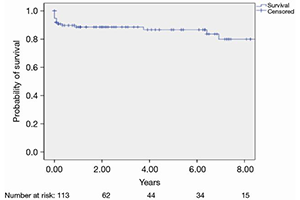Hypertrophic obstructive cardiomyopathy—the Leipzig experience
Abstract
Background: Management of hypertrophic obstructive cardiomyopathy (HOCM) has evolved considerably over the last fifty years, and includes medical treatment as well as septal myectomy (SM) to relief symptoms caused by left ventricular outflow tract obstruction (LVOTO). We report the Leipzig Heart Center experience in the surgical management of patients with HOCM.
Methods: We collected data from all patient treated surgically with a myectomy for LVOTO in patients with HOCM between 1997 and 2016. Patients with absent data were excluded from our analysis. All data were obtained from our surgical database and analyzed retrospectively.
Results: We identified 115 patients who underwent surgical treatment for HOCM, where a male:female ratio of 1.1:1, a mean age of 60.8±14.6 years and a body mass index of 27.7±4.5 were observed. The most common symptom was dyspnea (n=102). Of all patients, 50% had New York Heart Association (NYHA) III class symptoms. Arterial hypertension was the most common comorbidity (n=80). Preoperative transthoracic echocardiography showed a mean ejection fraction (EF) of 65.9%±9.7%, median septal thickness of 21.1±5.3 mm, systolic anterior motion of the mitral valve (MV) in 61.7% of patients, and mean LVOT gradient of 70.1±45.2 mmHg. Surgery resulted in a mean decrease of the septal thickness by 15±3.7 mm and LVOT gradient by 9.7±8.5 mmHg. Isolated SM was carried out on 20 patients. Postoperatively, we were able to notice a significant improvement in NYHA classification, in which patients with NYHA III benefitted most from SM. Long-term follow-up data up to 11.3±0.7 years were available for 114 patients. During follow-up, 16 patients died, and one patient was lost to follow up.
Conclusions: Surgical treatment of LVOT in patients with HOCM is an effective intervention that improves cardiac function and quality of life (QoL) and is associated with a low operative risk.
Cover






